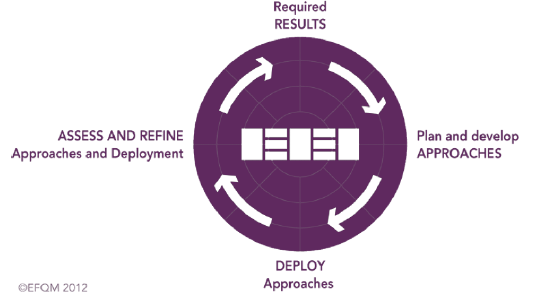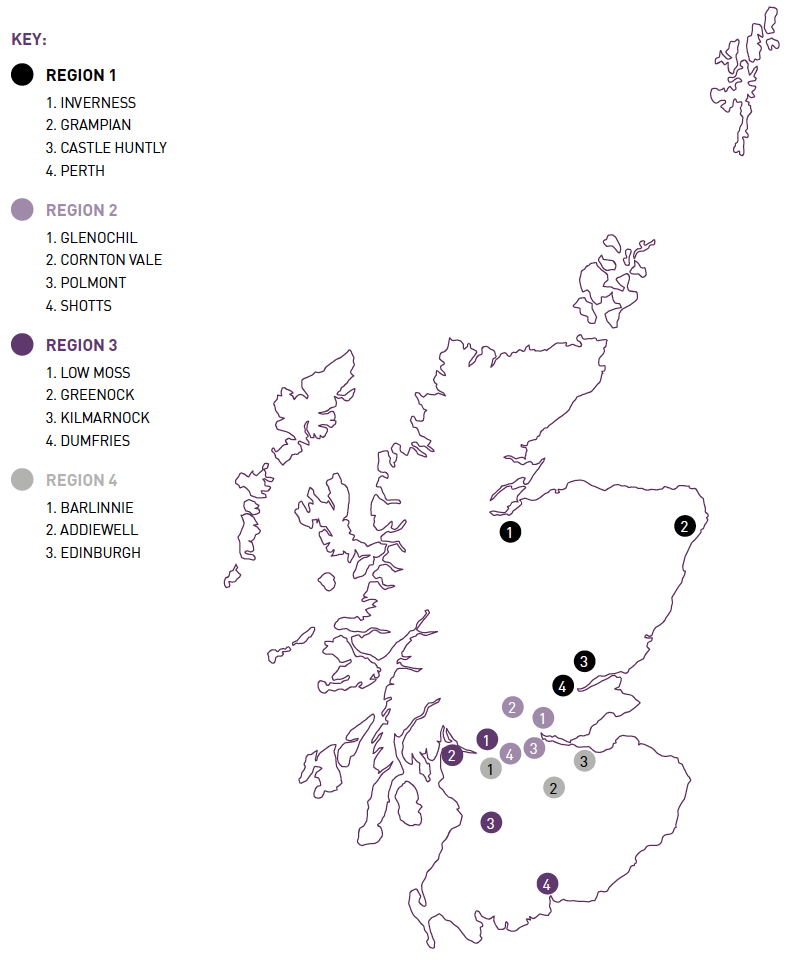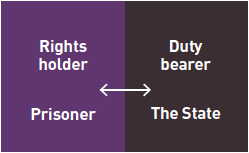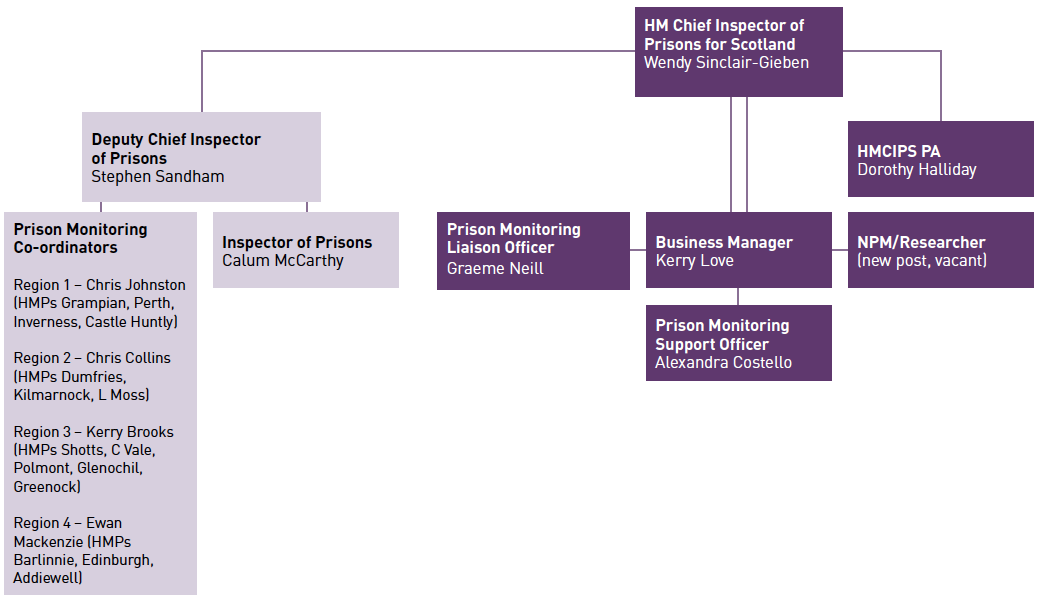ISBN 9781787816992 (web only publication)
PPDAS 556230
This document is also available in pdf format (1.1MB)
Contents
Foreword by HM Chief Inspector Of Prisons For Scotland
About Us – Who we are and what we do
The UK National Preventative Mechanism (NPM)
Key achievements over the last three years
Key strategic priorities and organisational objectives For 2019-2022
Key business plan objectives for 2019-20
Annex A – Organisational structure
Annex B – Map of prison monitoring regions
Annex C – A Human Rights Based Approach - Panel Principles
Foreword

I am delighted to introduce my Strategic Plan for 2019-2022.
On taking up post as HM Chief Inspector of Prisons for Scotland (HMCIPS) in July 2018, I undertook to develop a three-year Strategic Plan for the Inspectorate with an accompanying Business Plan. This Strategic Plan sets out an ambitious programme to build on the Inspectorate's successes and continue to deliver a credible, competent and collaborative Inspectorate that strengthens public confidence and supports continuous improvement.
It also provides the blueprint for the future and I have set out the Strategic Objectives for the period 2019-22, together with an overview of our Business Plan's key priorities for 2019-20.
To be truly effective, the Inspectorate's strategic planning and implementation will centre around four key activities:
- Full and effective management support to drive forward rigorous effective scrutiny, and promote a culture of continuous improvement.
- Internal and external communication of the Inspectorate's vision and planning commitments.
- Strengthen organisational planning and analysis.
- Maximise employee and partner engagement in shaping and delivering the Inspectorate's commitments.
The changes that have occurred in the last three years, with the introduction of prison monitoring, means the Inspectorate now has the capability to redesign its approach to be more flexible, transparent and effective. This recognition drives the first strategic objective, where the Inspectorate will be working collaboratively with its inspection partners Healthcare Improvement Scotland (HIS), Education Scotland, the Scottish Human Rights Commission (SHRC), the Care Inspectorate and Children and Young Peoples Commissioner Scotland (CYPCS) to co-design a risk-based approach to inspection. This new approach will recognise the importance of the findings from Independent Prison Monitors (IPMs), utilise the considerable existing findings available, draw on our partners' best practice in scrutiny models and complement the existing Standards for Inspecting and Monitoring Prisons in Scotland that are founded on the Human Rights Based Approach – PANEL Principles (See Annex C). We will engage openly and fully with the Scottish Prison Service (SPS) when developing a new risk-based approach to inspection, without compromising on our commitment to independent scrutiny.
As part of that commitment, we will maintain a Business Plan that reviews the Inspectorate's progress, and ensures it operates effectively and efficiently towards our strategic priorities, whilst staying within our allocated budget.
This Strategic Plan gives a credible and coherent framework for the continuing development of HM Inspectorate of Prisons for Scotland (HMIPS). Our vision, values, strategic ambition and key priorities will guide the next three years of our work and development. I am confident that they are principles and values that build on the achievements of the last three years and resonate strongly with our own staff, the team of volunteer IPMs and our key partners. As ever, I am most grateful to all of them for their dedication and commitment, and look forward to working with them as we take forward these important strategic initiatives.
Wendy Sinclair-Gieben
HM Chief Inspector of Prisons for Scotland
Introduction
During the last three years HMIPS completed Fourteen full inspections, Four return visits and Five court custody inspections
About us – who we are and what we do
HMIPS was established on 1 January 1981, following the publication in 1979 of a report by the Committee of Inquiry into the United Kingdom Prison Services (The May Committee). This report recommended that there should be a system of inspection of the Prison Service, distanced as far as may be practicable from the Prison Department. Subsequently, the post of HMCIPS was approved and the role was placed on a statutory basis by the Prisons (Scotland) Act 1980.
HMCIPS is required to inspect the 15 prisons across Scotland in order to establish the treatment of, and the conditions for prisoners, and to report publicly on its findings. The Public Services Reform (Inspection and Monitoring of Prisons) (Scotland) Order 2015 came into force on 31 August 2015, and from that date HMCIPS assumed overall responsibility for the monitoring of prisons, which is carried out on a day-to-day basis by approximately 120 volunteer IPMs. HMIPS inspect and monitor against a set of published Standards, which were reviewed and relaunched in May 2018.
HMCIPS also has responsibility for the inspection of the treatment of and conditions for prisoners under escort, and there is a separate set of Standards for these inspections.
HMCIPS produces and publishes an Annual Report that is presented to the Scottish Ministers and laid before Parliament.
HMIPS is an independent body. The regular monitoring and inspecting of prisons and other places of detention provides an important safeguard and a reassurance to the public. Such scrutiny needs to be conducted effectively, identifying both areas of good practice and where improvements should be made. The requirement to report these findings publicly contributes to public confidence in the criminal justice system.
The current Chief Inspector, Wendy Sinclair-Gieben was appointed in July 2018.
The UK National Preventive Mechanism (NPM)
HMIPS is one of twenty one organisations that comprise the UK National Preventative Mechanism (NPM). All our inspections contribute to the UK's response to its international obligations under the Optional Protocol to the UN Convention against Torture and other Cruel, Inhuman or Degrading Treatment (OPCAT). HMCIPS is a member of the NPM Steering Group. During 2014/15, a Scottish NPM subgroup was established, comprising the six member organisations in Scotland. The NPM publish an Annual Report of their findings.
Over the last 3 years IPMs completed over 2700 prison monitoring visits and dealt with almost 3000 requests from prisoners
Our Vision
"All people in places of detention are treated humanely, with dignity and respect"
Our Values
We will demonstrate these values in the way that we work together as an organisation and in all of our interactions with our partners.
Independence
We will fulfil our statutory duty to report accurately, impartially and publicly concerning the treatment and conditions for prisoners in Scotland.
Transparency
We will be open and transparent about our inspection and monitoring processes, and ensure our inspection and monitoring reports are accessible when we report publicly on our findings.
Integrity
We will demonstrate the highest professional standards of behaviour and build trust with all those we engage with.
Respect
We will treat all people we engage with, with dignity, courtesy and respect.
Key achievements over the last three years
During the last three years' HMIPS completed Fourteen full inspections, Four return visits and Five court custody inspections
- The production of Standards for inspecting court custody provision in Scotland
- Carried out a thematic study on the experience of older prisoners in Scottish prisons, and published a report in July 2017 entitled Who Cares? The lived experience of older prisoners in Scotland's prisons. This report highlighted the growing challenges of meeting the needs of an increasingly old and infirm prison population – social care, healthcare, activities, family contact, mobility, and personal fears. It also highlighted the need for a clear strategy for older prisoners. The report was well received and provoked considerable interest and debate.
- HMIPS was delighted to receive Investing in Volunteers (IiV) accreditation in 2018, in relation to the IPM role. IiV is the UK quality standard for all organisations which involve volunteers in their work.
- Contributed to the work of the NPM Steering Group and the Scottish NPM Subgroup.
- Undertook a review of the Standards for Inspecting and Monitoring Prisons in Scotland's quality indicators in May 2018, to express as clearly as possible what would be monitored and inspected under each of the nine Standards. We also placed the Human Rights Based Approach – PANEL Principles at the core of all of our monitoring and inspection activities.
- Gave evidence to Parliamentary Committees on issues that affected prisoners; prisoner voting, the use of remand, the Management of Offenders (Scotland) Bill and Home Detention Curfew.
- Undertook a review of the arrangements for Home Detention Curfew within the Scottish Prison Service to provide assurance for Ministers, the Parliament and the public.
Over the last 3 years IPMS completed over 2700 prison monitoring visits and dealt with almost 3000 requests from prisoners
Our strategic ambition
"To be recognised globally as leading edge in the scrutiny of how people in detention in Scotland are treated"
Our Key Partners
Our prison inspection teams comprise HMIPS staff and subject experts from other organisations. HMIPS would like to take this opportunity to thank its key partners for their continued support. Our five key partners are:
Healthcare Improvement Scotland (HIS)
HIS takes lead responsibility for inspecting Standard 9 – Health and Wellbeing. One of the biggest and often most challenging elements of prison inspections is the inspection of prisoner healthcare. Standard 9 was developed in conjunction with HIS and a range of their key stakeholders, and the quality indicators under the Standard reflect a human rights approach as well as the Health and Social Care Standards: My support, my life principles and HIS Quality of Care Approach.
Education Scotland
Education Scotland participate in all prison inspections and take lead responsibility for inspecting Standard 6 – Purposeful Activity. This Standard focuses on evaluating how well prisons provide employment, training and educational activities for prisoners while they serve their sentences, and is one of the key differentiators in reducing reoffending. Education Scotland also consider whether prisoners spend their time purposefully and constructively in out of cell activities, including physical education and cultural activities.
Care Inspectorate
The Care Inspectorate take lead responsibility for Standard 7 – Transitions from Custody to Life in the Community. They look at what support is in place in the lead up to people being released, and importantly what support is in place once released, to assist people to reintegrate into the community and become responsible citizens.
Scottish Human Rights Commission (SHRC)
The SHRC provide an important contribution to every prison inspection by providing an expert view on whether prisoner's human rights are upheld. Their findings are incorporated into the HMIPS final report. They also assisted us in developing the revised quality indicators for our inspection and monitoring Standards, which are based on the Panel Principles.
Children and Young People's Commissioner Scotland (CYPCS)
The Children and Young People's Commissioner Scotland promotes and safeguards the human rights of children and young people under 18, or up to 21 if they have care experience. During prison inspections where establishments hold prisoners under the age of 18, the office of the Children and Young People's Commissioner are invited to review the prison against international human rights standards. Their findings are incorporated into the HMIPS final report.
Key Priorities for 2019-22
Key strategic priorities and organisational objectives for 2019-22
In this Strategic Plan, HMIPS seeks to share its vision for the organisation and its strategic priorities for the next three years.
Our priorities directly support our vision for the organisation. They define the key ways in which we believe we can positively contribute to the Scottish Governments National Performance Framework.
HMIPS' five strategic objectives for 2019-2022 are:
Strategic Objective 1:
Develop a more strategic approach to inspection and monitoring
To deliver this objective our organisational objectives are to:
- Co-design and develop a risk-based approach to a new inspection framework, with our partners and the SPS
- This will include a validated self-evaluation framework for informing inspections and supporting a culture of continuous improvement within prisons
- Professionalise members of the inspection
- Recruit a qualified researcher to analyse our findings from inspection and monitoring to inform our future work
Strategic Objective 2:
Increase awareness and external confidence in the objectivity and robustness of the inspection and monitoring process
To deliver this objective our organisational objectives are to:
- Review the Standards for Inspecting and Monitoring Prisons in Scotland, in consultation with stakeholders, and make refinements where appropriate
- Embed a culture of continuous improvement through
- effective training and induction for inspectors and IPMs
- professional accreditation for inspectors and enhanced training for IPMs
- 'critical friend' challenge when assessing and triangulating evidence
- ensuring that our inspection and monitoring reports are accessible
- ensuring that any follow up action plan is transparent
- Increase awareness of monitoring through improved stakeholder engagement and communication
Strategic Objective 3:
Introduce more effective analysis and accessible recording and reporting of data collected during inspection and monitoring, and use it to inform best practice
To deliver this objective our organisational objectives are to:
- Recruit a qualified researcher to analyse our findings from inspection and monitoring to inform our future work
- Develop a strategic performance framework and a risk assessment framework for inspection and monitoring
- Review the existing prison monitoring recording and reporting system
Strategic Objective 4:
Improve our organisational capacity and invest in our people
To deliver this objective our organisational objectives are to:
- Undertake a capacity modelling exercise
- Devise and implement a revised staffing structure
- Complete a training needs analysis and skills matrix for each role
- Develop a comprehensive training plan
Strategic Objective 5:
Improve our knowledge and understanding of best practice internationally in inspecting and monitoring the treatment and conditions for prisoners
To deliver this objective our organisational objectives are to:
- Explore alternative inspection models through improved engagement and communication with other scrutiny bodies
- Work with NPM partners to define best practice in the UK
- Recruit a qualified researcher to provide us with current knowledge of scrutiny methods that apply to our business
Key business Plan Objectives For 2019-20
RADAR

The RADAR logic is a dynamic assessment framework and powerful management tool that provides a structured approach to questioning the performance of an organisation.
Our key priorities are:
Monitoring
- Raise the profile of Independent Prison Monitoring
- Develop our IPMs, to include inter-prison visits
- Review the existing prison monitoring, recording and reporting framework and improve accessibility, consistency and standards in reporting
- Revision of the IPM Guidance Document
Inspection
- Professionalise the inspection team
- Introduce cross-deployment and shadowing of peer scrutiny bodies
- Review our pre-inspection process, to include validated self-evaluation as part of a development risk management framework
- Review guest inspector training and guidance
Business Support
- Produce a Communications and Engagement Strategy
- Review our business planning processes
- Prepare for renewal of Investing in Volunteers status
- Review our ICT systems to support the business
Annex A
Organisational Structure
Annex B
Map of prison monitoring regions

Annex C
A human rights based approach – panel principles
Our Standards for Inspecting and Monitoring Prisons in Scotland and their associated Quality Indicators have at their heart the upholding of the human rights of those detained in prison. The Standards articulate what is expected of a well-run prison, and contain very clear statements identifying what is important and what will be monitored and inspected.
We have adopted an approach underpinned by the PANEL principles.
What is PANEL?

The central components to a human rights-based approach have been distilled into five principles: Participation, Accountability, Non-discrimination and equality, Empowerment and Legality.
The PANEL principles provide a framework by which it is possible to analyse and assess the human rights impact of decision making as well as providing guidance for the state, in terms of how to make decisions and implement processes. By using accessible language, PANEL translates the wide variety of human rights law minimum standards so that they can be better understood and applied.
Participation
Prisoners should be meaningfully involved in decisions that affect their lives.
Accountability
There should be monitoring of how prisoners' rights are being affected as well as remedies when things go wrong.
Non-Discrimination and Equality
All forms of discrimination must be prohibited, prevented and eliminated. The needs of prisoners who face the biggest barriers to realising their rights should be prioritised.
Empowerment
Everyone should understand their rights, and be fully supported to take part in developing policy and practices which affect their lives.
Legality
Approaches should be grounded in the legal rights that are set out in domestic and international laws.

